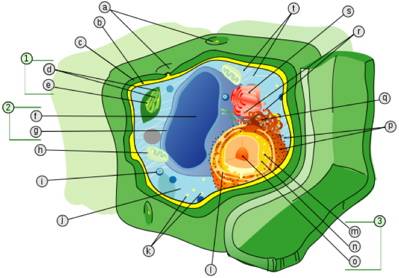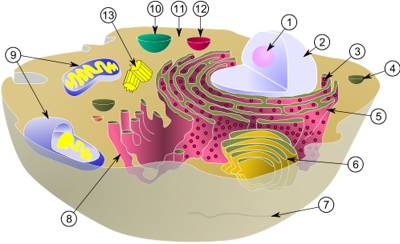The Eukaryotic Cell
|
|
 Eukaryotic Cell Structure: Plant cell showing, a. plasmodesmata,
b. plasma membrane, c. cell wall, 1. chloroplast, d. thylakoid,
membrane, e. starch grain, 2. vacuole, f. cell sap, g. tonoplast,
h. mitochondrion, i. peroxisome, j. cytoplasm, k. small
membranous vesicles, l. rough endoplasmic reticulum,
3. nucleus, m. nuclear pore, n. nuclear envelope, o. nucleolus,
p. ribosomes, q. smooth endoplasmic reticulum, r. Golgi vesicles, s. Golgi apparatus, t. filamentous cytoskeleton (Enlarged view).
Eukaryotic Cell Structure: Plant cell showing, a. plasmodesmata,
b. plasma membrane, c. cell wall, 1. chloroplast, d. thylakoid,
membrane, e. starch grain, 2. vacuole, f. cell sap, g. tonoplast,
h. mitochondrion, i. peroxisome, j. cytoplasm, k. small
membranous vesicles, l. rough endoplasmic reticulum,
3. nucleus, m. nuclear pore, n. nuclear envelope, o. nucleolus,
p. ribosomes, q. smooth endoplasmic reticulum, r. Golgi vesicles, s. Golgi apparatus, t. filamentous cytoskeleton (Enlarged view).
 Eukaryotic Cell Structure: Animal cell showing 1. nucleolus, 2. nucleus,
3. Ribosome, 4. vesicle, 5. Rough endoplasmic reticulum, 6. Golgi apparatus,
7. cytoskeleton, 8. smooth endoplasmic reticulum, 9. mitochondrion, 10. vacuole, 11. cytosol, 12. lysosome, 13. centriole (Enlarged view).
Image: Messer, Woland and Szczepan 1990.
Eukaryotic Cell Structure: Animal cell showing 1. nucleolus, 2. nucleus,
3. Ribosome, 4. vesicle, 5. Rough endoplasmic reticulum, 6. Golgi apparatus,
7. cytoskeleton, 8. smooth endoplasmic reticulum, 9. mitochondrion, 10. vacuole, 11. cytosol, 12. lysosome, 13. centriole (Enlarged view).
Image: Messer, Woland and Szczepan 1990.
A eukaryotic cell has a membrane-bounded nucleus. Cells of this type are found in protoctists, plants, fungi, and animals. Humans are eukaryotes, as are oak trees, mushrooms, and amoebas. Many, but not all, eukaryotic cells contain additional membrane-bounded organelles (e.g., mitochondria, chloroplast, Golgi bodies, etc.). The name eukaryote is derived from Greek eu-, meaning true, and karyon, denoting nucleus.
Eukaryotes compose one of the three primary divisions of cellular life. The other two, Archaea and Bacteria, are the prokaryotes, simple single-celled organisms. In general, eukaryotes have multiple, linear chromosomes, whereas a prokaryote has a single, circular chromosome that is not enclosed in a membrane.
In a eukaryote, cell division differs from that of prokaryotes, primarily with respect to the fact that it involves multiple chromosomes that must be sorted out and properly segregated when the cell divides. A prokaryote simply makes a copy of its single chromosome and places one copy into each of the two daughter cells produced when it divides by binary fission.
In a eukaryote, cells divide by means of a complex structure known a spindle apparatus, or simply "spindle." The spindle is composed of hairlike microtubules that stretch out from opposite poles of the dividing cell and draw one copy of each chromosome pair to each of the two poles. The cell then divides and the proper chromosomes have been distributed to each daughter cell.
Moreover, in eukaryotes there are two types of division, mitosis and meiosis. In mitosis, a single cell produces two daughter cells with the same number of chromosomes as the parent cell. In meiosis, which occurs, for example, in sexual reproduction during the production of gametes, the number of chromosomes is halved. The parent cell is diploid (it has two copies of each chromosome), the daughter cells are haploid (they have one copy of each chromosome) and four cells are produced instead of two as in mitosis.
Most shared on Macroevolution.net:
Human Origins: Are we hybrids?
On the Origins of New Forms of Life
Mammalian Hybrids
Cat-rabbit Hybrids: Fact or fiction?
Famous Biologists
Dog-cow Hybrids
Georges Cuvier: A Biography
Prothero: A Rebuttal
Branches of Biology
Dog-fox Hybrids